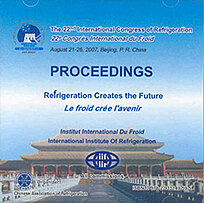
Summary
In Europe, mobile air conditioning (MAC) systems using R-134a will be tested as of 2007 in order to guarantee initial leak tightness, the annual emissions shall be lower than 40 g/year according to the Directive 2006/40/CE (EU, 2006). Leak tightness of almost all parts of MAC system is linked to the diffusion through polymeric materials (seals and hoses). Thus, permeation and diffusion of gas through these materials play a fundamental role in emission previsions. This paper focuses on mass transport mechanism of refrigerant through polymers and aims at identifying the permeation and diffusion coefficients of different types of materials. Simulation models for steady state and transient state, using finite element method, allows interpreting experimental results, and particularly for complex structures (hoses are multi-layer components). Based on experimental studies, a theoretical model is proposed to predict emissions of MAC hoses as a function of pressure and temperature.
Available documents
Format PDF
Pages: ICR07-B1-1594
Available
Public price
20 €
Member price*
Free
* Best rate depending on membership category (see the detailed benefits of individual and corporate memberships).
Details
- Original title: R-134a emission previsions based on identification of diffusion coefficient of polymers used in mobile air-conditioning components.
- Record ID : 2008-0368
- Languages: English
- Source: ICR 2007. Refrigeration Creates the Future. Proceedings of the 22nd IIR International Congress of Refrigeration.
- Publication date: 2007/07/21
Links
See other articles from the proceedings (839)
See the conference proceedings
Indexing
- Themes: Mobile air conditioning
- Keywords: Refrigerating equipment; R134a; Seal; Car; Modelling; Material; Leakage; Air conditioning
-
High efficiency and leak-tight future MAC systems.
- Author(s) : CLODIC D.
- Date : 2006/10/23
- Languages : English
View record
-
Flexible Kältemittelleitungen für CO2: Fahrzeug...
- Author(s) : BURKHARDT C., BALMER B.
- Date : 2005/11/16
- Languages : German
- Source: DKV-Tagungsbericht 2005, Würzburg./ 2005 Proceedings of the DKV Conference, Würzburg.
View record
-
Development of an automotive air-conditioning s...
- Author(s) : KOMATSU S., TSUNODA M., YAMAMOTO S.
- Date : 2000/12/07
- Languages : Japanese
- Source: The International Symposium on HCFC Alternative Refrigerants and Environmental Technology 2000: Latest technology for Energy Conservation, Refrigerants and Recycling on Air-Conditioning and Refrigeration Equipment for the 21st century. Proceedings.
View record
-
Compatibility of automotive air conditioning sy...
- Author(s) : ROHATGI N. D. T., VERDILE P. L.
- Date : 1994/10/24
- Languages : English
- Source: The 1994 International CFC and Halon Alternatives Conference. Stratospheric Ozone Protection for the 90's. Proceedings.
View record
-
Fuel-efficient, leaktight HFC-134a systems thro...
- Author(s) : FERNQVIST H.
- Date : 2003/02/10
- Languages : English
- Source: MAC Summit 2003. Options to reduce greenhouse gas emissions due to mobile air conditioning [CD-ROM].
View record
